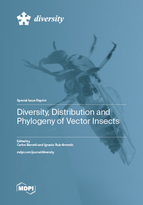Diversity, Distribution and Phylogeny of Vector Insects
A special issue of Diversity (ISSN 1424-2818). This special issue belongs to the section "Animal Diversity".
Deadline for manuscript submissions: closed (30 March 2023) | Viewed by 23117
Special Issue Editors
Interests: applied entomology, arthropod vector ecology; bluetongue; Culicoides; invasive species; mosquitoes; entomology surveillance; vector-borne diseases
Interests: entomology surveillance; medical and veterinary entomology; mosquitoes; one health; public health; Simuliidae; vector-borne diseases
Special Issue Information
Dear Colleagues,
Several hematophagous insects, including mosquitoes, biting midges, sand flies, and black flies, are able to transmit pathogens of veterinary and public health concern. There is a great diversity of blood-sucking insects, e.g., more than 3500 mosquito species and 2400 black fly species worldwide, with new species being discovered every year.
Immature stages and adults of this insects play an important role in the ecosystems since they are included in the diet of aquatic and insectivorous fauna; therefore, the diversity of these groups must be considered to understand their importance in ecosystem food webs. In addition, knowledge about their distribution, abundance, and phenology of vector insects is crucial to improve understanding of epidemiologic events and to manage control strategies as a way of preventing future disease outbreaks.
The phylogeny of insect vectors is also another issue to consider since phylogenetic studies help us to establish species delimitations, determine sibling species, and solve species boundaries. The One Health concept, supported by the World Health Organisation (WHO), states that public health is influenced by the environment, whether it is interconnected by public, domestic, or wildlife health. Climate change and globalization may impact the distribution and diversity of vector insects. Therefore, the expansion of their distribution range, due to the increase in temperature, the introduction of invasive species through public transport, or movements of breeding sites provoked by deforestation, enhances the impact on the distribution of vector species.
Dr. Carlos Barceló
Dr. Ignacio Ruiz-Arrondo
Guest Editors
Manuscript Submission Information
Manuscripts should be submitted online at www.mdpi.com by registering and logging in to this website. Once you are registered, click here to go to the submission form. Manuscripts can be submitted until the deadline. All submissions that pass pre-check are peer-reviewed. Accepted papers will be published continuously in the journal (as soon as accepted) and will be listed together on the special issue website. Research articles, review articles as well as short communications are invited. For planned papers, a title and short abstract (about 100 words) can be sent to the Editorial Office for announcement on this website.
Submitted manuscripts should not have been published previously, nor be under consideration for publication elsewhere (except conference proceedings papers). All manuscripts are thoroughly refereed through a single-blind peer-review process. A guide for authors and other relevant information for submission of manuscripts is available on the Instructions for Authors page. Diversity is an international peer-reviewed open access monthly journal published by MDPI.
Please visit the Instructions for Authors page before submitting a manuscript. The Article Processing Charge (APC) for publication in this open access journal is 2600 CHF (Swiss Francs). Submitted papers should be well formatted and use good English. Authors may use MDPI's English editing service prior to publication or during author revisions.
Keywords
- blood-sucking insects
- Culicidae
- Culicoides
- climate change
- community structure
- environment
- geographical dispersal
- mosquitoes
- One Health
- Phlebotominae
- phylogenetic analysis
- spatial and temporal distribution
- sand-flies
- species richness
- Simuliidae







